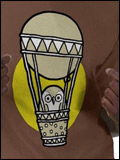This has been in the science media a couple times already, but anyone with a medium to big sized brain should read this article. The first section on “utility fog” is an extension and probably more realistic approach to Drexler's ideas about nanotechnology from the 1990s…. But the section titled “Quantum dots could create Camelot” is a big step more exciting to me.
Basically (and now I'll make clear my simplistic understanding of physics), you take an electron and confine it (laser pointers do this among many other quantum well devices) in three dimensions. At this point it is a quantum dot, which behaves as a standing wave or a probability density function or even just a cloud of electric charge.
The electrons trapped inside a quantum dot organize themselves like in an atom (but without a nucleus of course) — what they emulate is defined by the number of electrons and charges we apply to them. Also, quantum dots interact with other quantum dots in a way similar to atoms, but not limited to the same rules as atoms (so for example, rather than stable atoms limited to 92 electrons, we can build FAR larger dots). As they say in the article, “That's virtual chemistry, baby!”
We now know how to create a substance that can change it's physical properties! On a simplistic level, this means a few things:
- Superstrong substances — strong enough so we could build an elevator into space, reducing the cost of spacetravel to a millionth of what it is now.
- Superefficient solar panels — imagine a world where we need neither nuclear or fossil fuels.
- Weapons of unimaginable destructive abilities, coupled with shields of enormous strength.
I could go on and on. Read the article and start dreaming…



Post a Comment